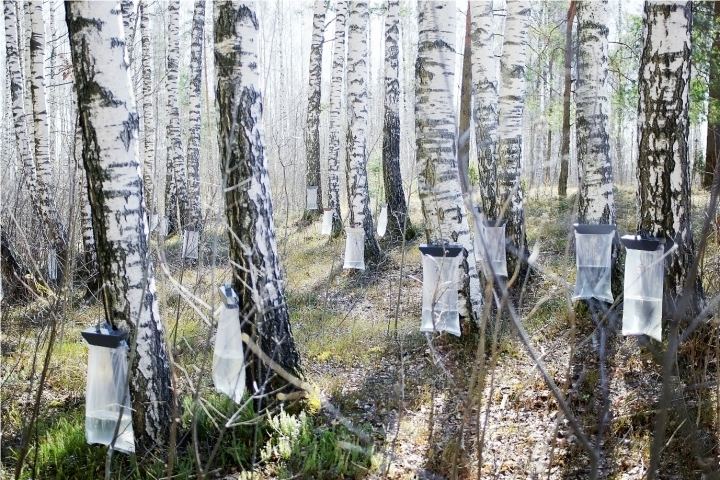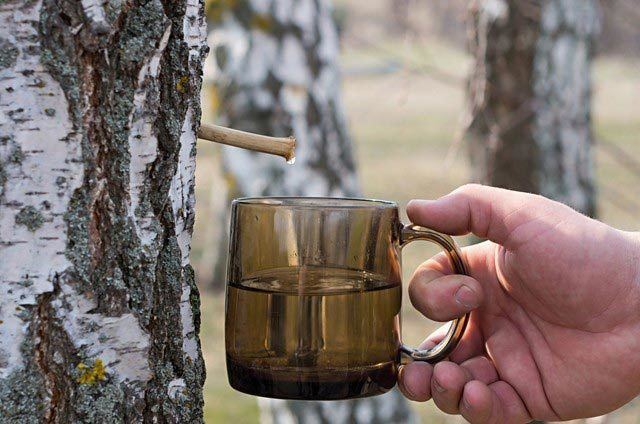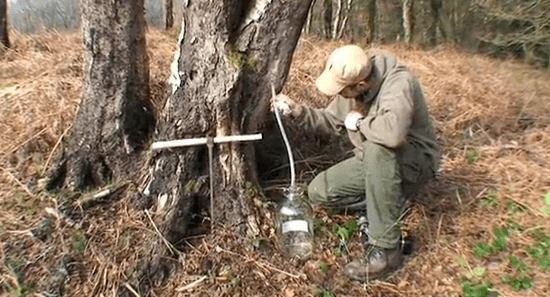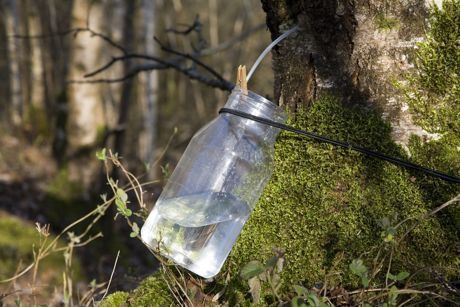Energy 4.6 kcal (19 kJ) Sugars 1.1 g Fat less than 0.1 g | Carbohydrates 1.1 g Dietary fiber 0 g Calcium (6%)60 mg | |
 | ||
Similar Kvass, Borodinsky bread, Mors, Tkemali, Acıbadem kurabiyesi | ||
Tapping birch trees for birch sap
Birch sap or birch water is the sap directly tapped from birch trees, Betula alba (white birch), Betula pendula (silver birch), Betula lenta, Betula papyrifera, and Betula fontinalis.
Contents
- Tapping birch trees for birch sap
- Birch sap beverage let s critique ep 72
- Harvest
- Traditional regions
- Composition
- Nutritional and medicinal uses
- Folk uses
- Commercial birch sap and derivative products
- References

Birch sap may be consumed both fresh and naturally fermented. When fresh, it is a clear and uncoloured liquid, often slightly sweet with a slightly silky texture. After two to three days, the sap starts fermenting and the taste becomes more acidic.

Birch sap is a traditional beverage in boreal and hemiboreal regions of the northern hemisphere as well as parts of northern China.
Birch sap beverage let s critique ep 72
Harvest
Birch sap is collected only at the break of winter and spring when the sap moves intensively. Birch sap collection is done by drilling a hole into its trunk and leading the sap into a container via some conduit: a tube or simply a thin twig: the sap will flow along it because of the surface tension.

Birch sap has to be collected in early spring before any green leaves have appeared, as in late spring it becomes bitter. The collection period is only about a month per year. Tapping a tree does not harm the health of the tree.
Traditional regions

Birch sap was a traditional beverage in Russia (Russian: берёзовый сок / byeryozovyi sok), Latvia (Latvian: bērzu sula), Estonia (Estonian: kasemahl), Finland (Finnish: mahla), Lithuania (Lithuanian: Beržų Sula), Belarus (Belarusian: Бярозавы сок / biarozavy sok, Byarozavik), Poland (Polish: sok z brzozy, oskoła), Ukraine (Ukrainian: Березовий сік / berezovyi sik), France, Scotland and elsewhere in Northern Europe as well as parts of Northern China.
Composition
Birch sap contains heterosides (betuloside and monotropitoside), 17 amino acids including glutamic acid, as well as minerals, enzymes, proteins, betulinic acid and betulin, antioxidants, sugar (xylitol, fructose and glucose) and vitamins (C and B(group)).
Nutritional and medicinal uses
Birch sap is commonly known for its detoxifying, diuretic, cleansing and purifying properties. Heterosides present in birch sap release methyl salicylate by enzymatic hydrolysis which is analgesic, antiinflammatory and diuretic. The activation of diuresis helps eliminating organic wastes such as uric acid and cholesterol. Birch sap may also used to treat hair loss, arthritis, and obesity.
Birch sap can be used in case of hyperuricemia and hypercholesterolemia and to treat kidney stones.
Folk uses
Folk uses vary from medicinal use, supplementary nutrition (minerals and vitamins) and cosmetic applications for skin and hair.
Commercial birch sap and derivative products
Birch sap may be consumed both fresh and naturally fermented. Fresh birch sap is highly perishable; even if refrigerated, it is stable for only up to 2–5 days. Shelf life can be prolonged by freezing or preservation techniques. Existing preservation techniques:
- Nothing i.e. bottled fresh sap (shelf life: 2-5 days refrigerated)
- Filtered with a 0,22μ net (shelf life: 3 weeks refrigerated)
- Collected under anaerobic conditions (shelf life: 1 year ambient)
- Added sugar (3g per 100ml)
- Heat pasteurized; pasteurization should be conducted under specific temperature levels and time spans (shelf life: 1 year ambient). Although level of Vitamin C is lower than fresh saps', all benefits are preserved
- Frozen at -25C (shelflife: 2 years)
Birch sap can also be used as an ingredient in food or drinks, such as birch beer or wintergreen flavored candy.
Concentrated birch sap is used to make birch syrup, a very expensive type of syrup mainly made from paper birch in Alaska and Canada, and from several species in Russia, Belarus and Ukraine.
